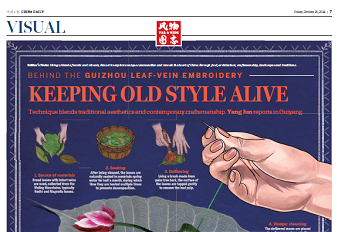Guizhou's ancient beauty a magnet for international visitors
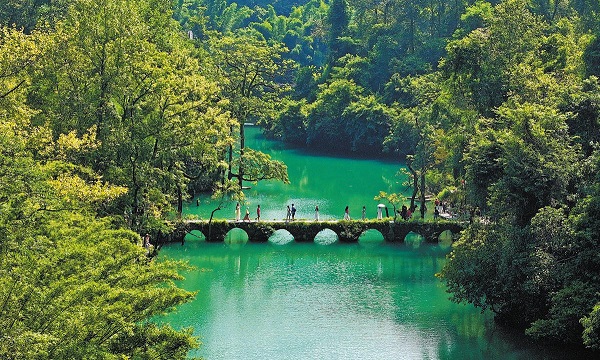
The Xiaoqikong scenic area in Libo county, Guizhou province, is a captivating destination for nature lovers. LEI SHENG/FOR CHINA DAILY
Visual artists from around the world recently explored the beauty and uniqueness of Guizhou province in Southwest China at the five-day Visual@China Guizhou 2024 trip, which was jointly held by China Daily and the Publicity Department of the Communist Party of China Guizhou Provincial Committee. The artists used pictures, photos and videos to present and promote the region that abounds with picturesque natural scenery and cultural heritage.
Ahead of his first trip to China in September, Benjamin Thomas Kirchner, an illustrator from Bath, England, was intrigued by the magical, fairy tale-like beauty of the country's landscape and architecture, as depicted in ancient scrolls and modern films.
Kirchner had convinced himself the landscape and buildings surely wouldn't measure up to what he imagined, but that all changed when he visited Yunshantun village in Anshun of Guizhou province. Upon seeing the 600-year-old former military post, perched high on a hill and framed by white clouds against a breathtaking blue sky, he exclaimed: "I realized that what I thought was a fantasy or an exaggerated vision of Chinese rural scenery was very much a real thing."
As an illustrator who travels a lot and whose work is regularly seen in major international publications like The New York Times and The Washington Post, Kirchner said seeing the scenery of Guizhou with his own eyes was "incredibly stimulating and inspiring" — just like the fairy tale China of his imagination. "It has been a joy to photograph and sketch the surroundings, and I know this will inspire my creative work for a long time after this visit," he said.
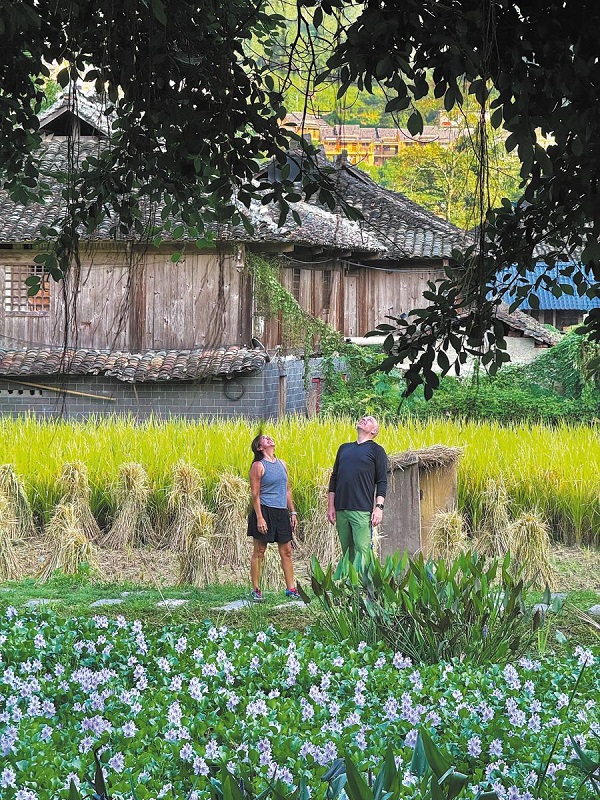
Foreign guests enjoy the natural scenery in Guizhou during the Visual@China Guizhou 2024 trip. WANG WENLAN/FOR CHINA DAILY
Kirchner was part of a recent trip called Visual@China Guizhou 2024, composed of 31 photographers, illustrators, designers and filmmakers from the United States, the United Kingdom, Germany, Italy, Spain, Peru, Laos, Malaysia, Nepal, Bhutan and China. William Adlington was another. As head of a media company in the UK, he has visited China many times, but most of his destinations are big cities. He was impressed by Yunshantun's houses and buildings, and expressed great admiration for the wood carvings and craftsmanship.
"This village is a good example of the countryside, with amazing and beautiful buildings. A very original and authentic village," Adlington said.
Villagers in Yunshantun are descendants of soldiers who were sent by the first Ming Dynasty (1368-1644) emperor to ensure regional peace, and their dialect, attire, diet and customs have changed little over the centuries. Adlington was also wowed by the Xiaoqikong Scenic Area in Libo county. This enchanting national park, which is included on the list of UNESCO World Heritage Sites, is known for its unique karst landscape and magnificent water features. Xiaoqikong, which literally means "seven small arches", is surrounded by lush greenery and a crystal clear river, creating a dreamlike atmosphere.
Walking the narrow paths, visitors to Xiaoqikong are treated to breathtaking views of cascading waterfalls, emerald pools and limestone formations. Adlington was especially impressed by the waterfalls and different species of butterflies. "I have never seen such butterflies back in the UK. For those who love nature, I would recommend they come to Guizhou," he said.

With the meticulous arrangements of the Guiyang section at China Railway Chengdu Group, Robert Bruce Montgomery II, a documentary producer from the United States and first-time visitor to China, celebrates his 60th birthday on the Guiyang-Nanning High-speed Railway. YANG JUN/CHINA DAILY
Yaoshan village, an ethnic Yao settlement in Libo, also drew praise from the international travelers. Local residents create and sell products that feature both modern aesthetic elements and their ethnic features, without having to leave parents and children behind to work in plants in big cities. Richard Max Gavrich, a professor at the California College of the Arts, praised that approach, saying it is one of the best ways to keep ethnic culture and traditions alive.
Guizhou is much more than natural scenery and ethnic charm. The mountainous province is also home to nearly half of the world's 100 highest bridges, including the Baling River Bridge, which stands 370 meters and extends approximately 2,237 meters. It has become a hot destination for extreme sports, including bungee jumping and high-altitude swings. The commercial bungee jumping site at Baling River Bridge has been certified by Guinness World Records as the world's highest.
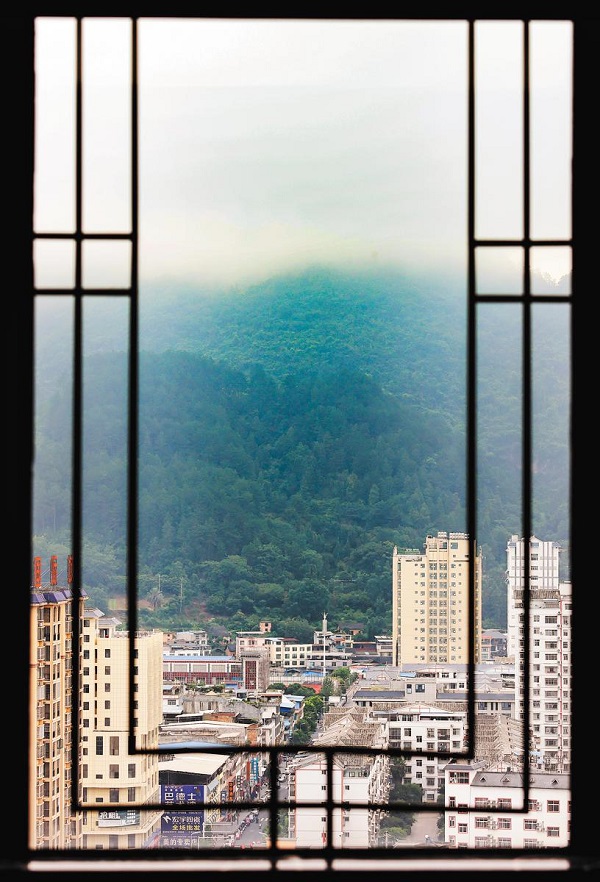
A view from a hotel in Guizhou's Libo county. LAN HONGGUANG/FOR CHINA DAILY
James Anthony Gensheimer, a photographer from the US, expressed his astonishment at the development of cities in Guizhou province and said the advanced bridges and technologies were beyond his expectations. "I knew little about China and nothing about Guizhou, but by standing here, I feel it is really different from what I learn from the media," said Gensheimer.
In recent months, China has rolled out several visa-free policies and measures to facilitate inbound tourism, leading to an influx of global travelers to popular destinations including Guizhou.
The inland province has sought to further expand its market presence. It has organized promotional events, focusing on culture, tourism as well as trade, in key markets, including France, the US, Canada, Indonesia, Thailand, Laos, Singapore, Japan and South Korea. These initiatives have boosted cooperation between Guizhou and these important sources of tourists.
The event, Visual@China Guizhou 2024, represents an innovative exploration in visual expression and global communication by Guizhou.
Based on what they have seen and experienced in the province, the experts are creating a series of artistic works that reflect their individual styles.
Via their lens and brushes, the beauty of Guizhou, with its lush landscapes and vibrant ethnic culture, as well as its openness and vitality, will be seen by a larger audience in the world, presenting a more authentic, multidimensional, and comprehensive image of China.
京ICP备13028878号-8







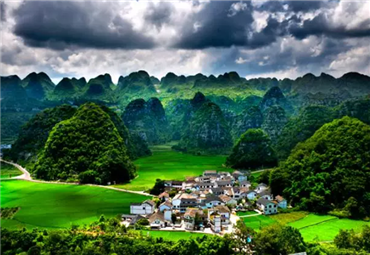 Overview
Overview Guiyang
Guiyang Guian New Area
Guian New Area Liupanshui
Liupanshui Anshun
Anshun Qianxinan
Qianxinan Qiandongnan
Qiandongnan Qiannan
Qiannan Zunyi
Zunyi Tongren
Tongren Bijie
Bijie 75 years on: Guizhou's great leap to prosperity
75 years on: Guizhou's great leap to prosperity China (Guizhou) Intl Alcoholic Beverages Expo
China (Guizhou) Intl Alcoholic Beverages Expo Video: Diplomats discover China's beauty in Guizhou
Video: Diplomats discover China's beauty in Guizhou 
